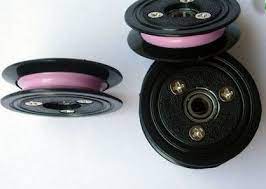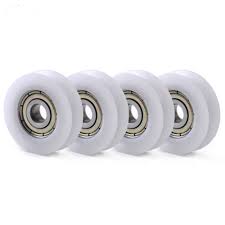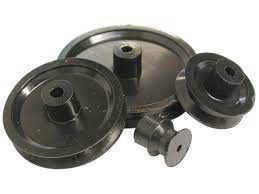Product Description
Customize Rubber & Plastic & PU products
— According to samples or drawings
For fast quotation, please confirm below details;
1. Product type
2. Size (provide samples or 2d/3d drawings for reference)
3. Specific material (or let us using environment)
4. Quantity request
5. Prefer color
Our Manufacturing Capabilities
Technology Our Services
Rubber Injection molding Product Design
Plastic Injection molding Mold Making
Over&insert molding Material Modification
Compression molding Logo Printing
Urethane cast molding Surface Treatment
CNC machining Assembly
Extruded Custom Packaging
Vacuum forming Door to Door Delivery
Product Details
Products Type
We can OEM any kinds of Roller wheel as your requirment.
| Product Specifications | |
| Material | Nylon ,mc nylon, POM,ABS,PU,PP,PE,PTFE,UHMWPE,HDPE,LDPE, PVC,etc. |
| Color | Black, white, red, green, transparent or any color according to Pantone code |
| Size | As per customer’s requirements |
| Technology | Injection molding, CNC machining, Extrusion,vacuum forming,Compression molding,Over molding&insert molding |
| Surface Treatment | Powder coating, Zinc coating, Galvanization, Electro-deposition coating, Chrome/zinc/nickel plating, Polishing, Silkscreen, Black oxide |
| Application | Automotive, ATV, Mechanical equipment, Construction, Home appliance, Aviation, Office facilities, Agriculture, etc. |
| Biggest Part Size | 1500*1500*1000mm |
| Tolerance | 0.01mm–0.001mm |
| Drawing Format | STEP/STP/IGS/STL/CAD/PDF/DWG and Other |
| Packaging | Can be customized packaging |
| Shippment | We have longterm cooperation with internation shipping agent and express company, so that shipping safty and arriving time are secured |
| Service | Product & Mold Design and Making,Material Modification,Surface Treatment,Assembly,Custom Packaging |
Products Specification
- Various type for your choice.
- Good abrasion, heat and oil resistance.
- Good anti-aging performance and gas tightness.
- Ease of bonding to other material.
- Excellent oxygen and CHINAMFG resistance.
- Non-flammable,self-extinguish.
Main Product Range
Our Factory
Our Certification
Zhongde is a SGS verified manufacture. We have passed ISO9001:2005 quality control certifacation as well as environment management certification.
Company Profile
Zhongde (ZheJiang ) Machinery Equipment Co.,LTD is a company integrated in design,OEM&ODM plastic&rubber&CNCparts production.We can provide the best products and service at a competitive price.
Our Machine
We have different types of machines to meet different requriements. Most our machines were imported from overseal. The highest rotate speed of CNC machining center can reach to 20,000RPM. The largest vulcanize rubber machine can produce rubber parts within 3000mm.
Order Operation Flow
We execute each step according to the operation process flow, strictly, seriously and meet the requirements of customers with good quality on time.
/* January 22, 2571 19:08:37 */!function(){function s(e,r){var a,o={};try{e&&e.split(“,”).forEach(function(e,t){e&&(a=e.match(/(.*?):(.*)$/))&&1
| Certification: | CE |
|---|---|
| Pulley Sizes: | Type D |
| Manufacturing Process: | Forging |
| Samples: |
US$ 999/Piece
1 Piece(Min.Order) | Order Sample For sample price, package information, and logisti
|
|---|
| Customization: |
Available
| Customized Request |
|---|
.shipping-cost-tm .tm-status-off{background: none;padding:0;color: #1470cc}
|
Shipping Cost:
Estimated freight per unit. |
about shipping cost and estimated delivery time. |
|---|
| Payment Method: |
|
|---|---|
|
Initial Payment Full Payment |
| Currency: | US$ |
|---|
| Return&refunds: | You can apply for a refund up to 30 days after receipt of the products. |
|---|
Are there any limitations or temperature constraints with plastic pulleys?
Yes, there are certain limitations and temperature constraints associated with plastic pulleys. Here’s a detailed explanation:
1. Load Capacity:
Plastic pulleys have a limited load capacity compared to their metal counterparts. While they are suitable for many light to moderate load applications, they may not be suitable for heavy-duty or high-load scenarios. Exceeding the recommended load capacity of plastic pulleys can lead to deformation, premature wear, or failure of the pulley, compromising the overall performance and reliability of the system.
2. Temperature Sensitivity:
Plastic pulleys can be sensitive to temperature variations. Extreme heat or cold can affect the mechanical properties of the plastic material, leading to dimensional changes, reduced strength, or increased brittleness. High temperatures can cause the pulleys to deform or soften, while low temperatures can make them more prone to cracking or breakage. Therefore, it is important to consider the temperature range in which plastic pulleys will be operating and choose materials that can withstand the specific environmental conditions.
3. Thermal Expansion:
Plastic pulleys can exhibit thermal expansion, meaning they may expand or contract with changes in temperature. This can affect the precision and alignment of the pulley system. In applications where precise positioning or tight tolerances are required, thermal expansion of the plastic pulleys should be taken into account to ensure proper functioning of the system. Compensation techniques, such as using adjustable mounting brackets or incorporating thermal expansion calculations, may be necessary to maintain alignment under varying temperature conditions.
4. Chemical Compatibility:
Some plastic materials used in pulleys may not be compatible with certain chemicals or solvents. Exposure to chemicals that are incompatible with the plastic material can lead to degradation, discoloration, or weakening of the pulleys. It is important to consider the chemical environment in which the plastic pulleys will be used and select materials that are resistant to the specific chemicals present in that environment.
5. UV and Weather Resistance:
Not all plastic materials used in pulleys have excellent resistance to ultraviolet (UV) radiation or outdoor weather conditions. Prolonged exposure to sunlight or harsh weather elements can cause degradation, discoloration, or loss of mechanical properties in certain plastics. If plastic pulleys are intended for outdoor or UV-exposed applications, it is crucial to choose materials that are UV-resistant and weather-resistant to ensure long-term durability and performance.
6. Static Electricity:
Some plastic pulleys can generate static electricity during operation. This can be a concern in certain applications where static discharge can interfere with sensitive electronic components or create safety hazards in potentially explosive environments. In such cases, anti-static or conductive plastic materials may need to be used to mitigate the risks associated with static electricity generation.
In summary, plastic pulleys have limitations and temperature constraints that should be considered during their selection and application. These limitations include load capacity, temperature sensitivity, thermal expansion, chemical compatibility, UV and weather resistance, and static electricity generation. By understanding and addressing these constraints, it is possible to use plastic pulleys effectively and ensure their optimal performance and longevity in various mechanical systems.
What role do plastic pulleys play in automotive engines and accessory systems?
Plastic pulleys play an essential role in automotive engines and accessory systems. Here’s a detailed explanation of the role of plastic pulleys in these applications:
1. Belt Driven Systems:
In automotive engines, plastic pulleys are commonly used in belt-driven systems. These systems include components such as the alternator, power steering pump, air conditioning compressor, water pump, and various accessory drives. Plastic pulleys are used as the guiding and tensioning components for the belts that drive these systems. They help maintain proper belt tension, ensure smooth operation, and facilitate the transfer of power from the engine to the various accessory components.
2. Lightweight Design:
Plastic pulleys offer the advantage of being lightweight compared to their metal counterparts. This lightweight design contributes to overall weight reduction in the vehicle, which is crucial for improving fuel efficiency and reducing emissions. By using plastic pulleys in automotive engines and accessory systems, manufacturers can achieve weight savings without compromising the strength and durability required for reliable operation.
3. Low Friction and Efficiency:
Plastic pulleys are designed to have low friction surfaces. This characteristic reduces the resistance encountered by the belts during operation, resulting in improved efficiency. The reduced friction helps optimize the power transfer from the engine to the accessory systems, ensuring that energy is not wasted and maximizing the overall efficiency of the vehicle. The use of plastic pulleys helps minimize energy losses and contributes to the performance and fuel economy of the automotive engine.
4. Corrosion Resistance:
Automotive engines and accessory systems are exposed to various environmental conditions, including moisture, heat, and chemicals. Plastic pulleys offer excellent resistance to corrosion, which is particularly beneficial in these demanding environments. Unlike metal pulleys that may rust or corrode, plastic pulleys remain unaffected by moisture or chemicals. This corrosion resistance ensures long-lasting performance and reduces the need for frequent replacements, contributing to the reliability and longevity of automotive engines and accessory systems.
5. Noise and Vibration Damping:
Plastic pulleys have inherent damping properties that help reduce noise and vibration in automotive engines and accessory systems. The damping effect of plastic materials absorbs vibrations generated during belt operation, resulting in smoother and quieter system performance. This is important for improving the overall driving experience and reducing the noise levels inside the vehicle cabin. Plastic pulleys help minimize noise and vibration, contributing to user comfort and the overall quality of the vehicle.
6. Design Flexibility:
Plastic pulleys offer a high degree of design flexibility, allowing for precise customization to match the specific requirements of automotive engines and accessory systems. They can be molded into various shapes, sizes, and configurations, enabling efficient integration into different engine layouts and space constraints. Plastic pulleys can incorporate features such as grooves, flanges, or mounting options directly into the design, ensuring optimal belt engagement and alignment. This design flexibility helps optimize the performance and reliability of automotive engines and accessory systems.
7. Cost-Effectiveness:
Plastic pulleys are generally cost-effective compared to their metal counterparts. The manufacturing process for plastic pulleys is typically less complex and less expensive, resulting in lower production costs. This cost advantage makes plastic pulleys a preferred choice in automotive applications where multiple pulleys are required, such as in serpentine belt systems. Plastic pulleys offer a balance between performance, durability, and affordability, contributing to the cost-effectiveness of automotive engines and accessory systems.
In summary, plastic pulleys play a vital role in automotive engines and accessory systems by guiding and tensioning belts, providing lightweight design, reducing friction and improving efficiency, offering corrosion resistance, damping noise and vibration, providing design flexibility, and delivering cost-effectiveness. Their contributions to these systems result in better performance, fuel efficiency, reliability, and overall driving experience in vehicles.
How do plastic pulleys contribute to effective belt or cable operation?
Plastic pulleys play a crucial role in ensuring effective belt or cable operation in numerous applications. Here’s a detailed explanation of how plastic pulleys contribute to effective belt or cable operation:
1. Reduced Friction:
Plastic pulleys are designed to have low friction surfaces. When a belt or cable passes over a plastic pulley, the reduced friction between the pulley and the belt or cable allows for smoother movement. This reduced friction minimizes energy losses, improves efficiency, and reduces wear and tear on the belt or cable. As a result, plastic pulleys contribute to effective and efficient operation by reducing the resistance encountered by the belt or cable during its movement.
2. Noise Reduction:
Plastic pulleys offer inherent damping properties, which help reduce noise and vibration during belt or cable operation. The damping effect of plastic materials absorbs vibrations and minimizes noise generation. This is particularly important in applications where quiet operation is desired, such as in office equipment or household appliances. By reducing noise and vibration, plastic pulleys contribute to effective belt or cable operation by providing a smoother and quieter system performance.
3. Wear Resistance:
Plastic pulleys are often engineered to be wear-resistant. They are designed to withstand the repetitive contact and rubbing of belts or cables without significant wear or damage. The wear-resistant properties of plastic pulleys ensure that the pulley maintains its shape and functionality over time, resulting in prolonged belt or cable life and consistent performance. By minimizing wear and extending the lifespan of the belt or cable, plastic pulleys contribute to effective and reliable operation in various applications.
4. Corrosion Resistance:
Plastic pulleys offer excellent resistance to corrosion. Unlike metal pulleys that may rust or corrode when exposed to moisture or certain chemicals, plastic pulleys remain unaffected by such corrosive elements. This corrosion resistance is particularly beneficial in environments where belts or cables may come into contact with moisture or chemicals, such as in outdoor machinery or marine equipment. By resisting corrosion, plastic pulleys ensure the longevity and reliable operation of belts or cables in harsh conditions.
5. Design Flexibility:
Plastic pulleys offer a high degree of design flexibility. They can be molded into various shapes, sizes, and configurations, allowing for precise customization to match the specific requirements of the belt or cable system. Plastic pulleys can incorporate features such as flanges, grooves, or mounting options directly into the design, ensuring optimal belt or cable engagement and alignment. This design flexibility contributes to effective belt or cable operation by providing a tailored solution that maximizes performance and minimizes the risk of belt slippage or misalignment.
6. Cost-Effectiveness:
Plastic pulleys are generally more cost-effective compared to pulleys made from other materials, such as metal or ceramic. The manufacturing process for plastic pulleys is typically less complex and less expensive, resulting in lower production costs. This cost advantage makes plastic pulleys a cost-effective choice for belt or cable systems, especially in applications where multiple pulleys are required. By offering a cost-effective solution, plastic pulleys contribute to effective belt or cable operation while keeping overall system costs under control.
In summary, plastic pulleys contribute to effective belt or cable operation through reduced friction, noise reduction, wear resistance, corrosion resistance, design flexibility, and cost-effectiveness. By providing smoother movement, minimizing wear, reducing noise and vibration, resisting corrosion, offering customized designs, and being cost-effective, plastic pulleys play a vital role in ensuring the optimal performance and longevity of belt or cable systems in various applications.
editor by CX
2024-03-03




